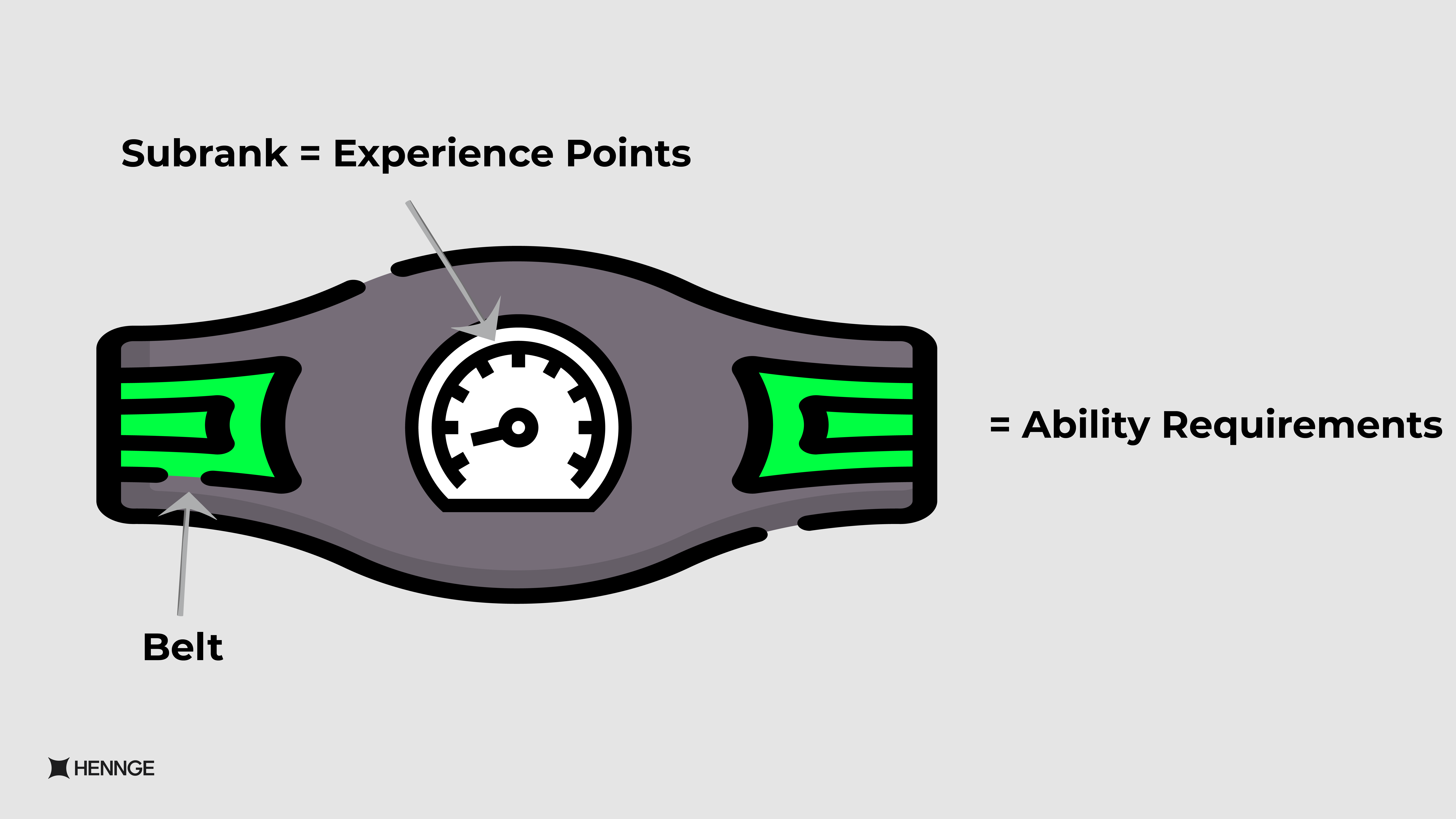

CEL OGIYA
Published on April 28, 2025
In judo, a Japanese martial art, the Mon Grade System, used in some countries, is designed for beginners to intermediate judokas (judo practitioners) and provides a structured, gradual progression to the next level. As judokas develop their skills and gain experience, they advance through a series of colored belts, each representing a different level of expertise on their path to mastery.
HENNGE’s MON system categorizes different job types, with its belt system—comprising seven levels—defining the capabilities and skills required for each role. Additionally, a subrank measures an individual’s performance and the extent of achieved outcomes within their current belt order.
Wondering how the interplay between MON, belt, and subrank shapes your career journey at HENNGE? Read on as we unravel these concepts in more detail, peeling back the layers to reveal a mosaic that outlines a clear and actionable roadmap to success.

In Japanese corporate culture, career advancement has traditionally been influenced by age and tenure. The annual nenji kouka (年次考課) or nenji satei (年次査定) assessment process often places considerable emphasis on seniority and length of service when making decisions about promotions and salary increases. As a result, employees who have been with the company longer are generally more likely to receive higher-level roles or pay raises.
While the concept of lifetime employment has contributed to job stability and fostered loyalty, it can also have its drawbacks. When individual performance is not prioritized, this can stifle innovation, as it tends to reinforce the status quo and adhere to societal norms rather than encouraging fresh ideas or challenging established practices.
HENNGE takes pride in being an international team with an agile mindset and a laid-back approach. Despite being in business for more than three decades, the company maintains a startup mentality, emphasizing practical solutions rather than predefined rules and procedures.
HENNGE promotes a strong culture of learning, where employees are encouraged to lead themselves, stay curious, and challenge conventional thinking to drive innovation and continuous improvement.
The MON System
At HENNGE, MONs, or job types, are categorized into nine distinct classifications:
- Global Product Development MON
- Cloud Sales MON
- Customer Success MON
- Solution Sales MON
- Solution Development MON
- Solution Project Management MON
- Solution Support MON
- Recruiting MON
- Speciality MON

Each MON has its own belt requirement. The Specialty MON functions more like a Common MON and is used for job types that do not have a corresponding MON classification—it serves as a broad category for general job types that do not fall under the existing MON classifications.
“Currently, HENNGE has nine MON classifications because it can be challenging to define every single job type, especially when job requirements need to be tailored to fit within the career ladder structure,” explains Toshihiro Takasu, Executive Officer of the People Division. “We use the Speciality MON system for roles that aren’t fully established yet, or for positions with only one or a few members. At HENNGE, MONs are created, eliminated, merged, split, or renamed as business and organizational needs evolve.”
The Belt System
The belt system defines the capability and skill requirements for each MON (role) or job classification. There are seven degree classifications, each corresponding to a different skill level, ranging from the highest to the lowest belt order:
- Platinum Belt
- Gold Belt
- Silver Belt
- Bronze Belt
- Brown Belt
- Green Belt
- White Belt
Each MON has a specific belt level, while each belt has a corresponding subrank range or salary level. The subrank system is similar to the accumulation of experience points in the belt order, where a higher belt reflects more advanced skill requirements. To increase their salary range, employees must meet the specific capabilities and skills to qualify for a higher belt level.

The Subrank System
The subrank system determines the exact salary within an employee’s belt order based on their historical performance at their current level. While the belt reflects an individual’s overall capabilities, their accumulated performance over time determines their subrank. In essence, the more consistent evidence of strong performance an employee provides, the higher their subrank—and corresponding salary range—will be. Conversely, if an individual consistently underperforms, their subrank and pay range may decrease accordingly. The subrank’s salary gradations reflect an individual’s performance within their current belt level and may be adjusted based on recent achievements or areas for improvement.
Unlike the belt level, which remains fixed for the medium term, the subrank may vary based on short-term performance, assessed during the annual evaluation every year.
“At the start of the fiscal year, a member sets their goals, and their performance is assessed against these goals. The extent of their achievements by the end of the year will directly influence their subrank for the following year,” Takasu says.
At HENNGE, leading oneself is the key to self-discovery, where opportunities are available to those who pursue them. With the right environment, feedback, and dedication, we believe that skills can evolve into expertise.
Ready to ante up your career prospects? Explore our job opportunities here and discover how far your passion can take you.